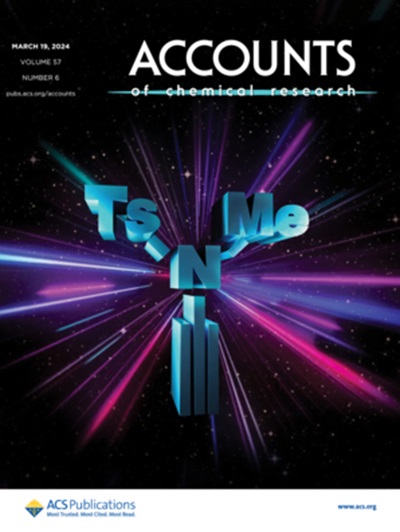糖基邻苯乙烯基苯甲酸酯作为碳水化合物从低聚糖到多糖的流线型一锅组装的供体。
IF 17.7
1区 化学
Q1 CHEMISTRY, MULTIDISCIPLINARY
引用次数: 0
摘要
碳水化合物是最重要和最丰富的生物分子,在许多生物过程中起着关键作用。然而,与蛋白质和DNA相比,碳水化合物的生物合成不是一个模板驱动的过程,而是一个循序渐进的过程,这导致了碳水化合物结构的异质性和复杂性。明确的、纯净的、充足的聚糖的可及性仍然是碳水化合物化学的瓶颈,阻碍了深入的生物学和功能研究以及基于碳水化合物的治疗方法的发展。为了解决这一问题,我们开发了以糖基邻苯乙烯基苯甲酸酯(PVB)作为多功能给体的糖基化反应,并在PVB糖基化的基础上开发了新的一罐糖基化策略,用于从低聚糖到多糖的碳水化合物的简化合成。这种新的糖基化反应方案的优点包括:(1)糖基PVB供体容易制备且贮存稳定;(2)启动子如NIS和TMSOTf价格便宜且易得;(3)糖基化产率一般为良好至优异,副反应少;(4)底物范围广;(5)方法操作简单;(6)该方法适用于一锅组装聚糖。与传统碳水化合物的分步合成、繁琐和耗时不同,基于PVB供体的一罐糖组装策略不仅加速了合成,减少了化学浪费,而且避免了苷元转移、离开物种的干扰以及与硫代糖苷一罐糖基化所固有的难闻气味等潜在问题。这些一罐式糖基组装策略主要包括四种策略:(1)利用PVB给体的正交性,通过PVB给体与其他给体如三氯乙酸糖基、n -苯基三氟乙酸糖基和正炔基苯甲酸盐的战略性组合,正交一罐式糖基化可以构建多种糖苷键,包括具有挑战性的1,2-顺式糖苷键;(2)利用PVB给体的高反应性,基于反应性的一锅糖基化可以通过PVB给体与巯基苷或n-Pen苷的组合实现高效的糖基化;(3)通过PVB供体的预活化,基于预活化的一锅糖基化可以实现不同糖苷键的高效组装,尤其是1,2-顺式糖苷键;(4)利用PVB给体的正交性和反应性,正交和基于反应性的一锅糖基化可以同时构建至少4个不同的糖苷键。事实上,基于PVB糖基化方法的一锅式聚糖组装策略已成功应用于具有重要生物活性的多种复杂碳水化合物的流线型全合成,包括植物聚糖(如霍山石斛中的十一糖和当归中的三十二糖)、真菌聚糖(如灵芝中的十一糖和香菇中的十四糖)、核苷(如卡普霉素、粘蛋白相关的肿瘤相关碳水化合物抗原,细菌聚糖,如来自普通拟杆菌的脂多糖,以及来自结核分枝杆菌的甘露糖覆盖的脂阿拉伯糖甘露聚糖(高达101-mer)。本文章由计算机程序翻译,如有差异,请以英文原文为准。
Glycosyl ortho-(1-Phenylvinyl)benzoates as Donors for Streamlined One-Pot Assembly of Carbohydrates from Oligosaccharides to Polysaccharides.
ConspectusCarbohydrates are essential and the most abundant biomolecules, with pivotal roles in numerous biological processes. However, in comparison with proteins and DNA, the biosynthesis of carbohydrates is not a template-driven process but instead a stepwise process, which results in heterogeneous and complex carbohydrate structures. The accessibility of well-defined, pure, and sufficient glycans remains a bottleneck in carbohydrate chemistry, impeding the in-depth biological and functional studies and development of carbohydrate-based therapeutics. To address this issue, we have developed new glycosylation reactions with glycosyl ortho-(1-phenylvinyl)benzoates (PVBs) as versatile donors and new one-pot glycan assembly strategies on the basis of PVB glycosylation for the streamlined synthesis of carbohydrates from oligosaccharides to polysaccharides.The advantages of this new glycosylation reaction protocol include the following: (1) glycosyl PVB donors are readily prepared and shelf-stable, (2) promoters such as NIS and TMSOTf are cheap and readily available, (3) glycosylation yields are generally good to excellent with few side reactions, (4) substrate scopes are broad, (5) the operation of the method is simple, and (6) the method is suitable for the one-pot assembly of glycans. Different from traditional carbohydrate synthesis that is stepwise, tedious, and time-consuming, new one-pot glycan assembly strategies based on PVB donors not only accelerated the synthesis and reduced chemical wastes but also precluded potential issues such as aglycone transfer, undesired interferences of the departing species, and unpleasant odor inherent to one-pot glycosylation with thioglycosides. These one-pot glycan assembly strategies mainly include four tactics: (1) by utilizing the orthogonality of PVB donors, orthogonal one-pot glycosylation could construct diverse glycosidic bonds, including the challenging 1,2-cis-glycosidic linkages, through strategic combinations of PVB donors with the other donors such as glycosyl trichloroacetimidate, N-phenyltrifluoroacetimidate, and ortho-alkynylbenzoates; (2) by utilizing the high reactivity of PVB donors, reactivity-based one-pot glycosylation could achieve efficient glycan assembly via the combinations of PVB donors with thioglycosides or n-Pen glycosides; (3) through preactivation of PVB donors, preactivation-based one-pot glycosylation could achieve the efficient assembly of different glycosidic linkages, especially 1,2-cis-glycosidic bonds; and (4) through utilizing the orthogonality and reactivity of PVB donors, orthogonal and reactivity-based one-pot glycosylation could construct at least four different glycosidic bonds simultaneously. Indeed, one-pot glycan assembly strategies on the basis of PVB glycosylation method have been successfully applied to the streamlined total synthesis of diverse and complex carbohydrates with important biological activities, including plants glycans such as the undecasaccharide from Dendrobium huoshanense and tridecasaccharide from Angelica sinensis, fungi glycans such as nonadecasaccharide from Ganoderma sinense and tetradecasaccharide from Lentinus giganteus, nucleosides such as capuramycin, mucin-related tumor associated carbohydrate antigens, bacterial glycans such as lipopolysaccharide from Bacteroides vulgatus, and mannose-capped lipoarabinomannan up to 101-mer from Mycobacterium tuberculosis.
求助全文
通过发布文献求助,成功后即可免费获取论文全文。
去求助
来源期刊

Accounts of Chemical Research
化学-化学综合
CiteScore
31.40
自引率
1.10%
发文量
312
审稿时长
2 months
期刊介绍:
Accounts of Chemical Research presents short, concise and critical articles offering easy-to-read overviews of basic research and applications in all areas of chemistry and biochemistry. These short reviews focus on research from the author’s own laboratory and are designed to teach the reader about a research project. In addition, Accounts of Chemical Research publishes commentaries that give an informed opinion on a current research problem. Special Issues online are devoted to a single topic of unusual activity and significance.
Accounts of Chemical Research replaces the traditional article abstract with an article "Conspectus." These entries synopsize the research affording the reader a closer look at the content and significance of an article. Through this provision of a more detailed description of the article contents, the Conspectus enhances the article's discoverability by search engines and the exposure for the research.
 求助内容:
求助内容: 应助结果提醒方式:
应助结果提醒方式:


